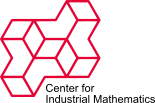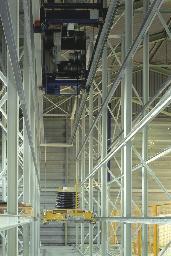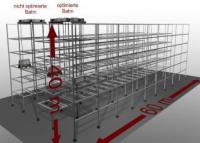Optimization in Logistics: Modelling and Real Time Optimal Control of a New High-Bay Warehouse Stacking System
| Working Group: | WG Optimization and Optimal Control |
| Leadership: | Prof. Dr. Christof Büskens ((0421) 218-63861, E-Mail: bueskens@math.uni-bremen.de ) |
| Processor: | Dr. Matthias Knauer ((0421) 218-63863, E-Mail: knauer@math.uni-bremen.de) |
| Funding: | Krusche Lagertechnik AG |
| Project partner: | Krusche Lagertechnik AG, Erding |
| Time period: | 01.11.2001 - 31.12.2004 |
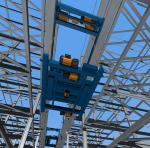
"All good things come from up above" is a well-known saying in the German language and, with this in mind, Krusche Lagertechnik AG developed a new stacking system for loading and unloading high-bay warehouses, the so-called TransFaster®, for which a patent has been filed. They created a lift system which can be moved horizontally and vertically to make it easier to stack high-bay warehouses: a positioning unit is connected to a load-carrying attachment by means of four cables. On the load-carrying attachment of the TransFaster® there is a transfer unit to pick-up and drop-off the transport goods. 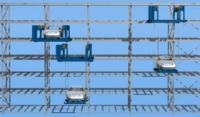
Since the TransFasters® are hung into different horizontal levels in the bay they can overtake each other. This achieves a greater efficiency (more storages and removals per unit of time compared with conventional stacker cranes), a higher availability (in the event of a malfunction the TransFasters® can replace each other in the high bay) and a greater flexibility (up to five TransFasters® can be used per aisle and different production and other areas can be directly linked) of the storage and removal processes. In addition, low wear and tear due to its light construction and a reduction in the number of material handling components in the pre-storage zone reduce the costs.
The coaxially attached, vertically controllable load-carrying attachments begin to vibrate in the transport to be optimised, however. Moreover, the optimised tracks must occur without collision and should preferably exhibit a reduced vibration behaviour. The vibrations of the load-carrying attachment at the end of the run must especially be prevented and further safety requirements met. This is achieved using a newly developed mathematical method for calculating the track curves and avoiding vibrations. The starting point of the solution is based on mathematical methods for solving generalised optimal control processes for autonomously acting systems under extended constraints. The software developed for this purpose combined with the technology of the TransFaster® provides surprising results: optimal tracks are calculated in real time which enables the TransFaster® to be positioned within the high bays with no vibration whatsoever in spite of the cable suspension. The performance specifications which can thus be achieved clearly surpass the conventional standards in the high-performance sector. The first prototype is already running successfully and received a varied positive response in the specialist press after it was presented to the public. The first areas of application are for pallets, crates, skids, coils and long goods.

